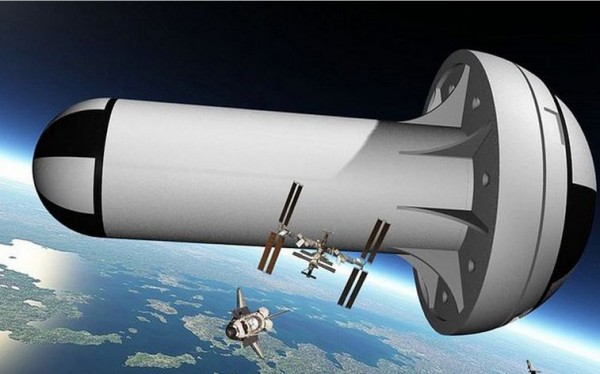Proposed ISS Replacement Looks Like a Big ****
| Arthur Dominic Villasanta | | Apr 13, 2015 01:54 AM EDT |
(Photo : USS) Gigantic Gaia Class Space Station with the ISS in the foreground
There's no way anyone can escape exclaiming a proposed space station to replace the International Space Station looks like, well, a huge male penis.
Some politely describe the "Gaia Class" space station being developed and marketed by United Space Structures (USS) as a huge mushroom or a gigantic space screw. The design of this suggestive space station isn't the only new thing about it, however.
Like Us on Facebook
Based in Washington, DC, USS bills itself as a "development, design and construction enterprise focusing on creating habitable environments to support research, manufacturing, entertainment and commerce in space".
The company founders are Bill Kemp, CEO and founder of the "FESSS space construction process", and Ted Maziejka, COO.
USS' Gaia Class space station will measure 100 meters in diameter and 400 meters in length. It will create artificial gravity by spinning around at a rate of 4.2 times per minute. This spin will generate a centrifugal force strong enough to force humans onto the curved floors that run around its edges.
Think of the curved space station in the movie, "2001: A Space Odyssey", to see how this works out in real life.
Spinning the space station will allow for long duration flights without the disabling effects of muscle and bone loss due to zero gravity. USS claims that physiologically and psychologically, the environment will be easier to adapt to than zero gravity.
The double wall system of Gaia's inner and outer hull is designed with a void between them. The rest of the interior volume will be filled with water that will act as the cosmic radiation shield and also the water reservoir for the station.
USS said its FESSS technology for building large cylindrical space structures will make the dream of a large habitable environment with variable gravity technically and economically feasible.
It says it's currently developing several robotic platforms that will have the capability to build a double walled structure cylindrical in shape and measuring 100 meters in diameter by 400 meters in length.
This will produce 2.8 million cubic meters of habitable interior volume. In comparison, the interior volume of the International Space Station, when completed, will be 1,000 cubic meters.
©2015 Chinatopix All rights reserved. Do not reproduce without permission
EDITOR'S PICKS
-

Did the Trump administration just announce plans for a trade war with ‘hostile’ China and Russia?
-

US Senate passes Taiwan travel bill slammed by China
-

As Yan Sihong’s family grieves, here are other Chinese students who went missing abroad. Some have never been found
-

Beijing blasts Western critics who ‘smear China’ with the term sharp power
-

China Envoy Seeks to Defuse Tensions With U.S. as a Trade War Brews
-

Singapore's Deputy PM Provides Bitcoin Vote of Confidence Amid China's Blanket Bans
-

China warns investors over risks in overseas virtual currency trading
-

Chinese government most trustworthy: survey
-

Kashima Antlers On Course For Back-To-Back Titles
MOST POPULAR
LATEST NEWS
Zhou Yongkang: China's Former Security Chief Sentenced to Life in Prison

China's former Chief of the Ministry of Public Security, Zhou Yongkang, has been given a life sentence after he was found guilty of abusing his office, bribery and deliberately ... Full Article
TRENDING STORY

China Pork Prices Expected to Stabilize As The Supplies Recover

Elephone P9000 Smartphone is now on Sale on Amazon India

There's a Big Chance Cliffhangers Won't Still Be Resolved When Grey's Anatomy Season 13 Returns

Supreme Court Ruled on Samsung vs Apple Dispute for Patent Infringement

Microsoft Surface Pro 5 Rumors and Release Date: What is the Latest?










